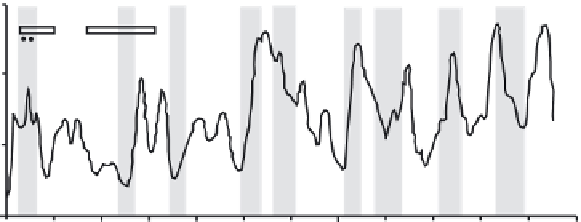Geoscience Reference
In-Depth Information
CE
CE
CE
CE
CE
CE
CE
CE
LIA
8
7
6
5
4
2
1
3
15
10
5
Fig. 3.11
Comparison of British
Holocene flood episodes with proxy
climate records for Britain, central
Europe and the North Atlantic,
well-date storm periods for Lake
Tutira, New Zealand, and flood
episodes in the upper Mississippi
basin, USA: LIA, Little Ice Age;
CE, central European cold-humid
phases (from Haas et al. 1998).
(Figure after Macklin & Lewin 2003.)
0
2
4
6
10
12
0
8
Calendar age in kyrs
British flood episodes
Climatic deteriorations inferred from mire wet shifts in Britain
Upper Mississippi flood episodes, USA
Lake Tutira storm periods, New Zealand
Central European cold-humid phases
Holocene records of North Atlantic drift ice
In the UK, Macklin & Lewin (2003) identified
14 major flooding phases, lying within the time
periods 400 -1070, 1940 -3940, 7520 - 8100 and
c
. 10,420 cal. yr BP. Although these are mainly
linked to variations in climate, forest clearance
and subsequent agricultural activity (see sec-
tion 3.4.1.1) were thought to prime the soils and
sediments for erosion and subsequent redis-
tribution by the floods, followed by alluviation
(Macklin & Lewin 1993, 2003) (Fig. 3.11).
Base-level changes, which are often linked
to climatic change (as well as tectonic uplift),
are responsible for the accommodation space of
fluvial sediments. In north-east Japan, low rates
of base-level rise have been related to the develop-
ment of large-scale channel fills, while rapid
rates have been linked to small-scale channels
(Komatsubara 2004). A drop of about 22 m in the
mean level of the Dead Sea over the past 70 years
resulted in a constant adjustment of the Lower
Jordan River (Hassan & Klein 2002). Here, rapid
drops in sea-level, particularly since the 1980s,
led to deep incision, changes in channel morpho-
logy and terrace development. Stable base-levels
are, in places, related to channel aggradation
and only minor lateral migration.
Even though climate change operates over both
long and short time periods, fluvial responses to
it are often rapid within these periods. Goodbred
(2003) demonstrated that the Ganges River
system in Bangladesh and India responded to
<
10
4
-year climate change in a system-wide, con-
temporaneous manner, with punctuated, rapid
sediment transfers. Lewis et al. (2001) discussed
climatic shifts within the last interglacial-glacial
cycle (125-10 ka), suggesting that these were
rapid and that they were recorded in alluvial
sediments. They described the changes in the
Thames, in which major changes in the alluvial
architecture were related to climatic fluctuations
at
c
. 70 ka and 13 -11 ka (the Devensian Late-
glacial climatic warm-cold-warm oscillations).
During Pleistocene cold stages, rivers in
northern Europe and America were similar to
contemporary cold-climate tundra rivers, with
overbank deposition in large, unconfined valleys,
rapid vertical aggradation of sandy material on
floodplains and limited lateral channel migra-
tion due to well-established tundra vegetation and
river bank cohesion (Kasse 1998). In areas with
little vegetation cover, large-magnitude spring
snow melts would have led to enhanced sedi-
ment erosion, transport and deposition. Thick
sequences of river gravels in northwest Europe
(Antoine 1993; Bridgland 2000) are thought to
have aggraded in such areas, as river environ-
ments changed from incisional to depositional
(Bridgland & Allen 1996). Cooling stages are
often recorded in the fluvial archive by channel
changes: in the Nochten area, eastern Germany,























